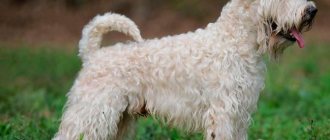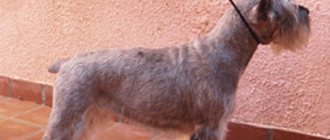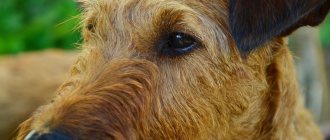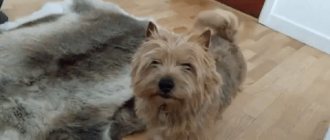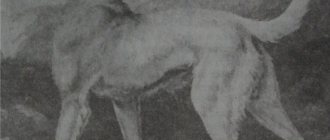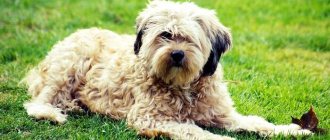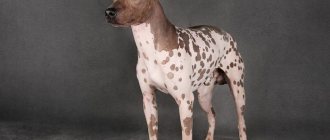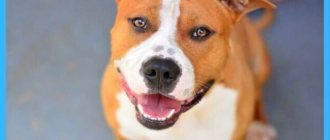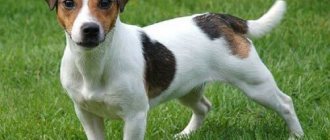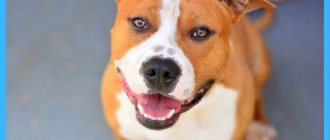Origin story
There is no reliable information about the origin of the Wheaten Terrier. All three Irish Terrier breeds are believed to have descended from a common ancestor, the tall-legged terrier with a reddish coat. In the mid-19th century, in a book about dogs in Ireland by H.D. Richardson named this type of terrier "Highend".
The Wheaten Terrier did not deserve the description and attention of such famous and rich people as Richardson, since it was considered a mongrel and was bred only by the poor. From the mid-19th century to the beginning of the 20th century, Irish terriers were not divided into breeds.
And at exhibitions taking place since 1873, terriers differed in color, size, and coat type. To create a brighter breed, the aboriginal terrier was crossed with English breeds. This is how three breeds of Irish terriers were created and recognized.
In the competition, the native wheat grass clearly lost and found itself on the verge of extinction. Only thanks to the efforts of Irish Blue Terrier lovers, the “Wheaten Terriers” were not only revived, but also received recognition as a separate breed.
Photo gallery
Photo 1. Irish Terrier at an exhibition
Photo 2. Photo 2. Wheaten terrier
Photo 3. The dog sits on the site
Description of the Irish Soft Coated Wheaten Terrier breed
The main characteristic of the appearance of the Irish Wheaten Terrier is moderation. He should not be too rough or too graceful - he is a working dog, bred by natural selection and most suitable for his task.
Height at the withers for a male is 46-48 cm (18-19 inches), for females - 42.5-45.5 cm. Weight for males is 16-18 kg, for females - 13.5-16 kg. According to the description, the terrier must meet the following parameters:
- The head is dry, narrow, with a small cranial region, tapering somewhat towards the eye sockets. The stopper is noticeable only in profile and is weakly expressed. The skull is tightly covered with skin and has no folds or plumbs.
- The jaws are strong, equipped with powerful muscles that should not stand out too prominently in the cheek area. The teeth are white, straight, complete dental formula. Scissor bite with upper incisors covering the lower incisors and complete contact.
- The nose is wide, not exceeding the length of the skull, with a well-developed lobe, colored black. The lobe protrudes beyond the decorative fur on the nose. The muzzle is square, without signs of narrowing.
- The eyes are medium-sized, oval, deeply set in the sockets. The eyelids fit tightly, the edges are black, which, together with the pronounced brow ridges and overhanging hair, gives the dog an expressive appearance. The iris is dark or dark hazel in color. Disadvantage: black or yellowish eyes.
- Ears medium size or small. The soft part of the ear is pressed to the skull in the temple area, the V-shaped tip is directed forward. The level of the inflection is located flush with the top of the skull. The ear plate is thin, covered on top with short hair, forming a short fringe along the edge.
- The neck is of medium length, with pronounced muscles, dry, cone-shaped. The profile shows a slight bend.
- The body is somewhat elongated, compact, with a straight back and shortened loin. The abdomen is moderately tucked.
- The chest is well developed, deep, the ribs are oval, elastic. The distance from the last rib to the pelvic bone is small.
- The fore and hind legs are of medium length, straight, with well-developed muscles.
- The paws are tightly gathered and round with black claws, but the standard allows for a different color. The pads are strong.
- The tail is of medium length and thickness. The natural look is raised vertically. Can be docked by 1/3. The tail is covered with coarser and shorter hair. There are no decorative hairs.
The appearance of the “wheat” leaves a feeling of strength, but not roughness. Movements are free and fast. Capable of developing good speed. Characterized by endurance and fearlessness. The dog is balanced, when standing with its head and tail raised, it gives the impression of being cheerful and playful.
Coat and colors
The coat is soft, silky, wavy, single-layered. In the head area it falls over the eyes. On the face the decorative hair forms a mustache and beard, on the neck and chest there is a collar, and on the paws there are fringes. The coat should not exceed 5-13 inches in length.
Only wheaten coat color of varying degrees of saturation is allowed - red, reddish-wheaten, golden. Puppies are born with a slightly different color. The main color of the coat is reddish or wheaten, but it can also be grayish due to the dark tips of the dog.
The mask may also be black, as well as a dark stripe along the spine. With age, the dark color disappears and the mask becomes lighter. The dark color remains only on the inside of the ear.
Changes in the structure and color of the coat occur between 18 months and 2.5 years. In this case, the transformation occurs in several stages. In an adult dog, the fur fits tighter to the body, forming large waves. In puppies it is shorter, denser and plusher.
Choosing a puppy
Wheaten terriers are very popular in America, Canada, and Scandinavian countries. In Russia and the CIS countries, the breed is still small and is only gaining popularity. Finding a nursery in large cities is not difficult, but there is a chance that there will be no puppies in it at the moment. Often babies from good parents have to be booked in advance and waited for some time.
The search for a puppy should begin with choosing a breeder and parents of the litter. They must suit you not only in appearance, but also in character. There is a possibility that their traits will be passed on to their offspring. Be sure to evaluate the conditions of keeping dogs, caring for them and the quality of feeding. It is very important that babies are properly raised in the first two months of life.
This increases the likelihood of raising a healthy, strong dog with a normal, stable psyche.
Wheaten Terrier puppies go through several stages of coat texture and color changes before acquiring their adult, mature coat between 18 months and 2.5 years. Babies are born reddish, grayish, often with black masks, a black “strap” along the back or black tips of hair on the body. As you grow older, the blackness disappears.
Small wheaten terrier puppies are distinguished by a very dark coat color, which completely changes color by 1.5-2.5 years.
Price
Irish Soft Coated Wheaten Terrier puppies from kennels usually cost from 35,000 to 45,000 rubles. The price is influenced by the geography of the nursery and its status, the quality of the producers and the prospects of the puppies. So pet-class babies are cheaper, while dogs, in which breeders see potential exhibition champions and future producers, can cost 50,000 rubles. And more expensive. The price of puppies without documents from parents with good pedigrees usually does not exceed 15,000 rubles.
Character traits
Devotion to family and love for children are the distinctive character traits of the Wheaten Terrier. The dog cannot tolerate separation from his family or loneliness. The dogs are obedient, but not without some character traits inherent in terriers, although less pronounced - aggressiveness and stubbornness.
Dogs show aggressiveness towards representatives of their tribe. Brave to the point of recklessness, the wheaten terrier can bark loudly at passing dogs and get into fights even with dogs that are larger than it.
“Pshenichnik” behaves like a puppy until his old age - he loves to play, run around, and be mischievous. To “let off steam” he needs to be involved in training and active games.
How to raise and train a pet
The Irish Wheaten Terrier is a highly trainable dog and is easy to train. All negative character traits are compensated by early socialization and upbringing.
"Wheat" is a smart dog. It is enough to repeat the commands several times and he learns and remembers them. A distinctive feature of the terrier's character is its willingness to follow commands from both adult family members and children, which makes it the best dog for an inexperienced owner.
The dog readily learns not only commands, but also circus tricks. The intelligence and ability to learn led to the service of Irish terriers during the Second World War in the medical and sapper troops. They were good signalmen and even sailors, as they can withstand motion sickness and do not suffer from seasickness.
Until the early 70s of the last century in Ireland, in order for a “wheat worker” to become a champion, he had to pass an examination for working qualities. Competitions were held:
- Testas Beag – hunting a hare or large rodent;
- Testas Mor - the ability to drive a badger into a hole, penetrate behind it and pull out the enemy alive or dead.
Today such competitions are not held, as they are very cruel, but the skills that were tested among the wheat farmers remain. Therefore, it is imperative to train dogs from early childhood so that the dog does not attack small pets and cannot accidentally injure a child.
Another characteristic property of “wheat” is its jumping ability. In the heat of the moment, a dog can jump up to the level of an adult’s face. If he is not weaned from jumping in his youth, then an adult dog with such “caresses” can pose a danger to elderly, weak people and children.
A well-mannered wheaten terrier is a model of obedience. This can be achieved through constant practice. A temperamental, cheerful and playful terrier should be the first to master prohibiting and calming commands. The instinct of pursuit is in his blood, so the dog must learn the command “come to me”, “stay”, “no”.
Experienced dog handlers warn that the wheaten terrier is an excellent actor and a born manipulator. He will not only try to ignore prohibiting commands, but will also pretend that such a ban from his beloved owner “broke his heart.” Firmness and consistency in training are required, as the terrier's habits can lead to illness, injury and even death of the pet.
“Wheat” is a magnificent athlete - tireless, dexterous, strong and fearless. Therefore, all activities on a special site are a pleasure for him, and maintaining physical fitness guarantees good health and a long life.
Care and health
The terrier's silky and fairly long coat requires daily brushing. Since it is single-layered and has no undercoat, the dog does not shed, and combing is necessary to avoid the formation of tangles and maintain a well-groomed appearance.
The dog does not require a special haircut, since even exhibition specimens are encouraged to look as natural as possible. The purpose of the haircut is to trim sloppy strands and emphasize the features of the exterior. It is better to bathe your dog when it gets dirty or before a show, using a special shampoo for long hair.
Caring for ears, eyes, teeth, and claws is required. Floppy ears do not ventilate well, so they need to be cleaned and inspected for ear mites and ear infections.
Teeth need to be brushed and the dog should be accustomed to this procedure from a very early age; you can also use dental products and bones to cleanse plaque and tartar.
Claws also require care. In urban conditions, the dog is deprived of the ability to naturally grind down its claws. If they are too long, they can injure the paw pads and cause discomfort during movement.
Vaccination, deworming and treatment against skin parasites should be carried out in a timely manner.
Mating
To breed Irish Terriers, you need to wait 2 years, when the maturation of the body is complete. Future parents can find each other through a kennel club or directly by agreement of the owners.
Dogs must have pedigree and show scores sufficient to participate in breeding. Only such representatives will be able to pass on all their advantages to their offspring. It is also necessary to check the availability of vaccinations according to age and the timeliness of treatment against helminths.
The pre-event meeting is held on neutral ground where the Irish can meet and play. After this, you need to move to the area that the male considers his. Mating is carried out in this territory, and then repeated at intervals of 1-2 days.
Read a detailed article on the topic: “Everything you need to know about breeding dogs: appropriate age, what to do if it doesn’t work out, rules and tips.”
Diseases of the breed
Since humans did not interfere very intensively in the selection of “wheat” crops, they are quite strong and have good health. But these active, mobile dogs may experience joint diseases, in particular dysplasia.
In addition, the following diseases occur in some wheat lines:
- Addison's disease - insufficient hormonal function of the adrenal glands;
- allergic reactions , including to food and medications;
- ectopia of the ureters is a rather rare disease in which, due to abnormal development of the urinary tract, constant leakage of urine occurs;
- progressive retinal atrophy;
- progressive nephropathy and renal dysplasia - kidney pathologies;
- pathology of the gastrointestinal tract and kidneys , causing the body to lose protein;
- cancer : skin, kidney, breast, bones.
Most of these diseases are not inherited, but are caused by a genetic malfunction during the prenatal period of development. In addition, owners of wheaten dogs should be aware of the intolerance of this breed to anesthesia.
With proper care, the use of preventative measures and regular examination, the Wheaten Terrier can live at least 12-15 years.
Key points in training
The Irish Soft Coated Terrier is a very smart animal. They learn easily and quickly understand what is wanted from them. Along with this, they are stubborn and cunning. They may pretend that they do not know what the owner means, turn away or ignore commands. It is important to consistently and persistently demand that tasks be completed, otherwise the dog will continue to act within the chosen strategy.
The use of force should not be allowed, as the dog will be offended and refuse to act. The ideal option is a game or reinforcement with a treat. It is possible to carry out training in hunting disciplines, but it will not be possible to instill protective guard skills due to the good nature of the dog.
Read about how to properly train a dog in the article: “Training a puppy: effective methods from dog handlers, learning commands at home.”
Feeding regimen and diet
To organize a dog’s proper diet, you need to know the characteristics of their metabolism and health. A large amount of protein food can cause eczema and atopic dermatitis in the Wheaten Terrier, and excess animal fat can cause indigestion and liver disease.
Therefore, preference should be given to vegetables and fruits, which wheat farmers eat with pleasure. Porridge, which is also necessary in the diet, should be represented by buckwheat and rice. Meat – low-fat varieties. A dog may have an allergic reaction to chicken.
During the growth period, the puppy should be given dairy products, low-fat soft cheeses, eggs, preferably quail and stewed vegetables flavored with sour cream. The wheatgrass diet should include sea fish.
Some dogs refuse ready-made food during puppyhood. Then breeders add stewed meat with gravy, liver or yogurt to it. Adult dogs arrange a “fasting day” for themselves, especially in the hot season. Wheaties tend to beg for food not because of hunger, but for the sake of contact with the owner and receiving positive emotions.
If the owner has opted for natural feeding, then it is important to maintain the daily intake of minerals and vitamins in the dog’s body. For this purpose, special complexes are prescribed.
If the owner prefers high-quality industrial diets (premium and super-premium), then no additional feeding is needed, since the feed contains all the necessary elements in sufficient quantities. The only thing is that when “drying” it is especially important to establish a drinking regime, providing your pet with clean drinking water.
Keeping a dog
The Wheaten Terrier is convenient for keeping in a city apartment, as it does not shed, takes up little space and, if properly trained, does not cause trouble for its owners.
The “Pshenichnik” takes root well in a country house, since the breed was originally a yard village dog. He needs territory to hunt, run, rummage in the ground - to satisfy his hunter instincts. But most of the time the dog should be in the house, so he has closer contact with people, which is very important for the dog’s mood and psyche.
Keeping it at home makes caring for the terrier's luxurious coat easier. When kept in an enclosure, making the dog look well-groomed is much more difficult. The dog does not require much physical activity. She enjoys playing both outside and inside the house. It is enough to walk her twice a day.
Theses
- IMPT can live in an apartment, private house, city or village.
- If you are obsessed with order, then these dogs may not be for you, as they love to run, jump, collect dirt and carry it into the house.
- They are not aggressive towards other dogs, but they do chase small animals.
- Wheaten Terriers do not tolerate heat well; in summer they need to be kept in an air-conditioned house.
- Terriers love to dig and the Soft Coated is no exception. Be prepared for trenches in your yard.
- They love the company of people and become stressed from loneliness.
- They love children and get along well with them.
- Independent and willful, training requires experience and knowledge.
- The Wheaten Terrier's coat sheds imperceptibly, but requires daily grooming.

